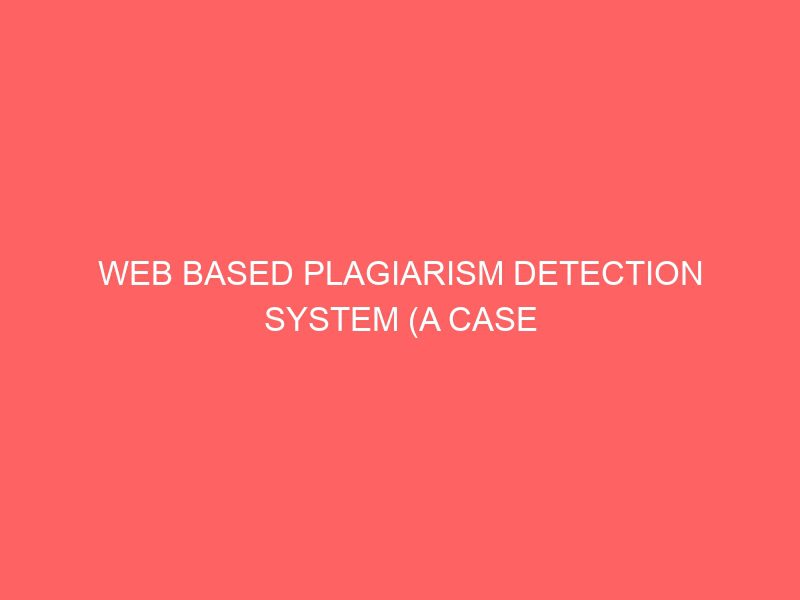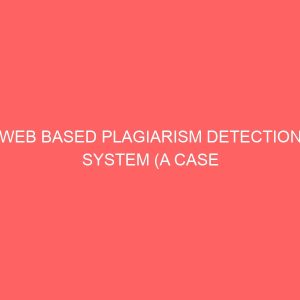Description
CHAPTERONE
INTRODUCTION
1.1 Background of the Study
This research is on Web based plagiarism detection system (a case study of university of Uyo, Uyo Akwa Ibom State). The motivation for this study is to achieve a platform that provides indispensable access to data source or material for learning and also generate check on academic environment to sustain academic integrity. The dual-purpose software uses computer and software system to support lecturers to give quality assessment to student work and student during their process of learning, understanding new concepts of certain discipline, while ensuring absolute independence and competence of such student on the subject at hand.
It is true that the world is fast growing in all aspect of discipline of which academic as the mother of all discipline is not excluded off course learning and research are the academic tools for idea innovations even though the limit of this global Civilization lies on lack of learning materials and resources.
The said software is flexible, portable, adoptable and interoperable. It has also brought to the bedroom of all the academic’s the center for learning without time constraints. Also, it has enhanced learning comfort which promote understanding and ideas conception. The other aspect of the software that checks plagiarism is as a result of some element of theft by student who believes in plagiarism. However, the use of Internet for data search have become compulsory in the aspect of research, and most students indulged themselves in a free and heroic act of copying other persons work without sincere gratitude or acknowledge an intellectual efforts and contributions of the source copied from.
Furthermore, the act of passing off another person’s effort, idea or words as one’s idea have set academic environment down and have rendered the field of professionalism incapacitated due to regular presentation of another person’s work with absolute less or no understanding of such work, resulting in a state of no new ideas and concepts which deteriorate an esteem academic integrity as well as discourages the sound minded ones that regularly come out with optimistic ideas, concepts, thought that resolves societal problems and enhance life.
Recently, it has been discovered that to maintain both academic and professional integrity is to revive individuals sense of ideas, thought and personal effort towards research by designing a sophisticated software.
1.2 Statement of the Problem
It is important to impact an excellence academic standard as a fundamental norm in the life of the students and the society at large in order to reveal individual potential and capability, but circumstantial factors such as unavailability of learning resources and plagiarism have affected both active and passive learners, respectively. It has become pertinent to fashion out the approach to these flows. No doubt it is much easier for students to find information online and copy rather than locating information via the library stacks and transcribing a passage by hand but they will not benefit from it. The phenomenon of plagiarism is found mostly in our higher education sector like Colleges of education, Universities, and Polytechnics etc. owing to the development of technology, it is easy for a lecturer to check the assignments of student through the Internet but the lecturer faces the problem of correcting and checking the quality of the assignments and detecting of plagiarized work or document, it is a very tedious work and it is also time consuming.
Plagiarism if detected may affect? An offender’s carrier with disadvantages to his intellectual capabilities. For example, one can plagiarize material or paper in getting a PHD for one’s self or securing a job or moving ahead to next level, when that level has not been merited.
1.3 Aim and Objective of the Study
The aim of this project is to enhance learning without any inferiority influence. The objectives of the research includes the following;
- To provide ultimate security on individual effort by comparing files to check plagiarism and acknowledge any research sources.
- To enable supervisors check students projects if they have been plagiarized.
- To provide ease of accessibility to plagiarized learning resources.
- To inculcate sense of gratitude on the learners or plagiarist as they must reference any book they copied and also acknowledge the intellects.
1.4 Significance of the Study
The need to designed an electronic learning system with a dual concept, this work will go a long way to reduce plagiarism to its minimum level. This will also go a long way in making the institution to appreciate the important of using electronic Learning system. Therefore, the project could be used as online learning center or online plagiarism checkers. It is automatic, speedy, save time used to search for Books, it enhance competition among researchers and the authors. It is also user- friendly and easy to use, due to the fact that software utilities used in the design and development are open source, and free to download from the internet. Free open source software may make development cheaper, but not necessarily make, the developed software package easy-to-use.
1.5 Scope of the Study
This research work covers the design and implementation of an online computer-base Application to combat plagiarism.
1.6 Limitation of the Study
The technology behind the design and implementation of the Electronic Learning System to checkmate Plagiarism is directed to online learning platform and plagiarism check between files (text, books, articles etc). Before the actual utilization of this software, learners are expected to get the software install in their computer system and the necessary interfaces depending on the software application which the learners want to work on as they cannot be used without proper installation and configuration of the software.
A user is expected to lunch configuration software online and upload either two different files for comparative check or import an online file to compare with the uploaded file, thus the only means to achieve plagiarism check.
1.7 Definition of Terms
Electronic Learning: Is a learning utilizing electronic technologies to access educational curriculum outside of a traditional classroom.
Plagiarism: Is the act of presenting someone else’s work or ideas as your own, with or without their consent, by incorporating into your work without full acknowledgement.
Ajax: Is the method of exchanging data with the server, and updating parts of a webpage without reloading the entire page.
Webcam: Is a video camera that feeds or streams its image in real time to or through a computer, the video stream may be saved, viewed or sent to other networks via system such as the Internet and emailed as an attachment.
Plagiarized: Is the act of copied and passed off as your own, “used plagiarized data in his/her thesis”, “a work dotted with plagiarized phrases”.
Website: Is a collection of related pages including multimedia content typically identified with a common domain name, and published on at least one Web server.
Plagiarism Detection: Is the process of locating instances of plagiarism within a document or work.
Dream Weaver: Is an application used by Web designers and developers to create Website and application for use across multiple target including browser, devices and tablets.
Software: Is a set of instructions or programs instructing a computer to do a specific task. It is a generic term used to describe computer programs and a set of instructions are the term often used to describe software.
Modula Design: Is a design approach that subdivides a system into smaller parts called Modules that can be independently created and then used in different system.








Reviews
There are no reviews yet.